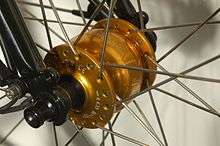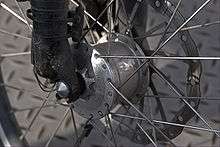Hub dynamo
A hub dynamo is a small electrical generator built into the hub of a bicycle wheel that is usually used to power lights. Often the hub "dynamo" is not actually a dynamo, which creates DC, but a low-power magneto that creates AC. Most modern hub dynamos are regulated to 3 watts at 6 volts, although some will drive up to 6 watts at 12 volts.


Models
The market was largely pioneered by Sturmey-Archer with their Dynohub of the 1930s–1970s. This competed effectively with contemporaneous bottle dynamos and bottom-bracket generators, but the Dynohub was heavy with its steel housing and was discontinued in the 1980s. Around 2009, Sturmey-Archer released new hub dynamo/drum brake units with an aluminum housing, designated X-FDD[1] and XL-FDD.[2]
The Schmidt Original Nabendynamo (SON) can power two 6-volt lamps in series at speeds above about 12 mph, and Schmidt manufactures lamps designed to facilitate this. These lamps have optics based on the Bisy FL road lights. The efficiency of the SON is quoted by the manufacturers at 65% (so just over 5 W of the rider's output is diverted to produce 3 W of electrical power) but this applies at only 15 km/h (10 mph). At higher speeds the efficiency falls. Bicycle dynamos instead use permanent magnets to eliminate the need for a battery to excite the field and initiate electrical generation.
Shimano offers a variety of hub dynamos under the "Nexus" brand, such as the DH-3N70/DH-3N71, advertised as having significantly less drag than the Nexus NX-30.
SRAM manufacture the i-Light hub dynamo. The D7 series is available for both rim and disc brakes while the D3 series features several of rim brake varieties. In a 2006 review by the German Stiftung Warentest, the efficiency at 15 km/h of a D1 series i-Light hub dynamo was 66%, 10% better than a SON-28.[3]
SR Suntour offer the DH-CT-630 hub dynamo series with integrated overvoltage protection.
SP Dynamo Systems offers about 10 different models of hub dynamos. Quick release hubs for disc brakes and rim brakes. Also a 15mm thru-axle for mountain bikes with disc brakes. They claim a very high efficiency and light weight compared to other hub dynamos currently on the market.[4] [5]
Efficiency
Improvements in design and materials have led to improvements in efficiency. Early designs had multiple copper windings and heavier magnets. Modern designs utilize stronger neodymium magnets, a single copper coil winding, and claw poles. Bicycle Quarterly reviewed seven different hub dynamos in 2005.[6] The SON28 was found to be the most efficient, although its cost was significantly higher than models from Shimano.
See also
References
- "Sturmey-Archer | X-FDD". Sturmey-Archer. 2017. Retrieved 31 January 2017.
- "Sturmey-Archer | XL-FDD". www.sturmey-archer.com. 2017. Retrieved 2017-01-31.
- Stiftung Warentest 03/2006 (German)
- Vintage Bicycle Quarterly Vol. 3, No. 4 (2005) – "Testing the Efficiency of Generator Hubs"
External links
- Sturmey-Archer hub dynamo
- Audax UK - Generators Compared.
- Testing by Chris Juden at Wilfried Schmidt Maschinenbau.
- Info on the Shimano Nexus system.